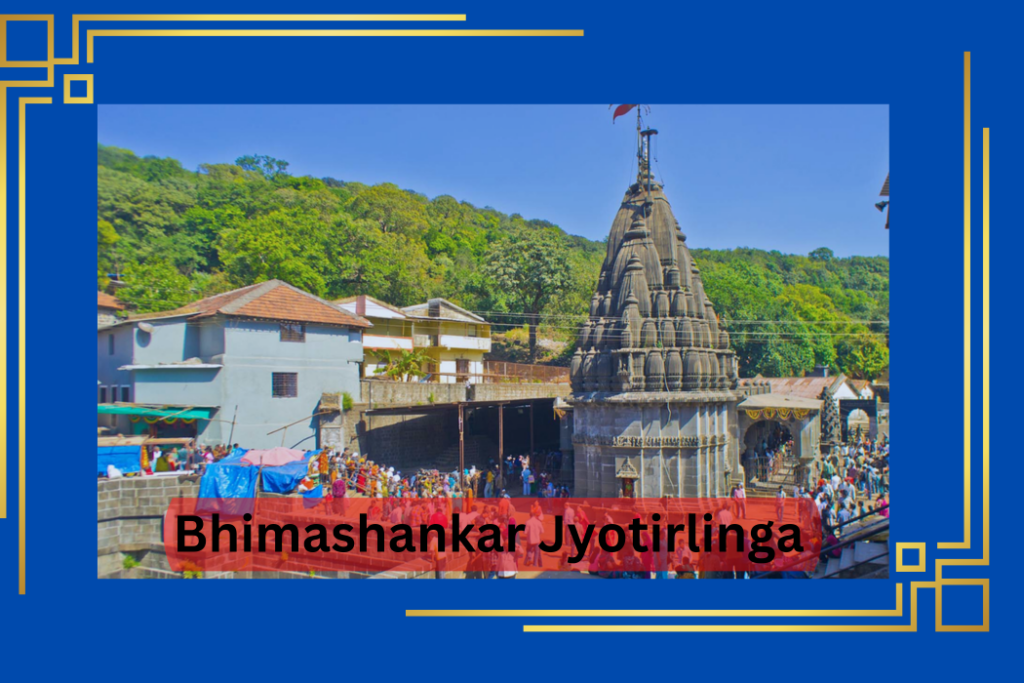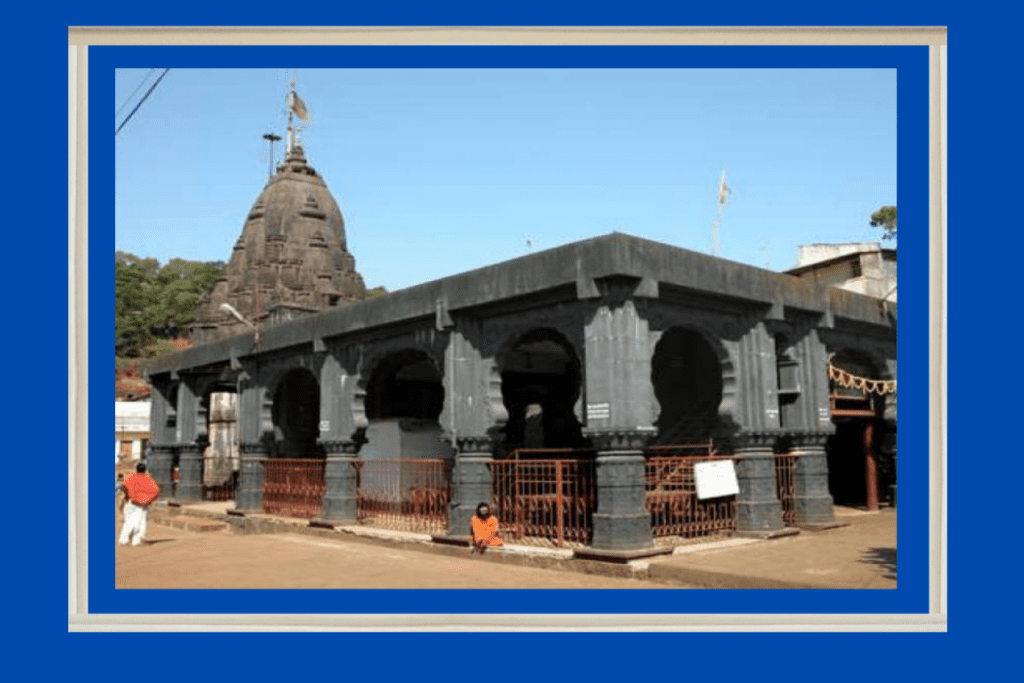Bhimashankar Jyotirlinga, Pune: History, Significance, and Travel
In this blog, we talk about the history, design, amazing places to visit, and the peaceful feeling that makes Bhimashankar Jyotirlinga a really great place to go.

Bhimashankar Jyotirlinga is one of twelve Jyotirlinga! It is located in Pune, Maharashtra. The main building is like a giant, dark rock castle with a super tall tower that seems to touch the sky. The walls are decorated with amazing pictures carved right into the stone, telling stories about all sorts of cool gods and goddesses.
Inside the most important room (called the garbhagriha), there’s a special symbol that represents Lord Shiva. It’s a super calming place where people can pray and just relax their minds. Imagine a sparkling pond where people can take a holy dip!
The complex of the Bhimashankar Temple extends beyond the impressive main structure. Located within the borders is a serene pond named Bhima Kund, believed to be the source of the Bhima River, a significant tributary of the Krishna River. Followers often submerge themselves in the refreshing waters of the kund, seeking purification and blessings.
In this blog, we talk about the history, design, amazing places to visit, and the peaceful feeling that makes Bhimashankar Jyotirlinga a really great place to go.
| Participate in online puja organised by VAMA(Get the puja done with your name and gotra) | |
| Name of Puja | Temple (Place) |
| Rin Mukti Puja | Rin Mukteshwar Mahadev Temple (Ujjain) |
| Shani Sade Sati | Shani Shingnapur Devsthanam ,Maharashtra |
| Rahu Grah Shanti Puja | Jarkutinatheshwar Mahadev Temple,Prayagraj |
| Bal Gopal Santaan Prapti Puja | Vrindavan Dham Kshetra ,Vrindavan |
| Sunderkand Path Rasraj Ji Maharaj ke sath | Lete Huye Hanuman Mandir, Prayagraj |
History and Story Behind the Bhimashankar Jyotirlinga
The mediaeval saints’ writings provide some of the first references to the Bhimashankar Temple, suggesting its enduring importance as a place of pilgrimage. During the 13th century, Saint Jnaneshwar, a prominent figure in Marathi Hinduism, embarked on a journey to Bhimashankar. His visit wasn’t unique; mentions of Saint Namdev, another well-known saint, visiting the temple before him indicate a long-standing pilgrimage route.
The early references from the 13th century show how significant the Bhimashankar shrine and the Bhimarathi River were in the spiritual realm of the area. Even though the temple’s precise beginnings are somewhat unknown, these literary allusions confirm its importance as a focal point of religious beliefs for many years.

Interestingly, the Bhimashankar Jyotirlinga Maharashtra present architecture appears to be quite recent when compared to its historical references. Several factors may be responsible for this apparent disconnection. Maybe the temple was renovated or expanded over time to accommodate the increasing number of worshippers. There is a chance that there were previous buildings at the location, constructed with materials that were not as long-lasting and have not survived over time.
Apart from support from the royal family, the daily religious rituals were upheld by donations from the community members. This shows a strong commitment to community participation and mutual dedication. The Bhimashankar Temple went beyond just being a place for religious practices; it evolved into a central hub for the community, promoting togetherness and a common goal.
The history of the Bhimashankar Jyotirlinga Maharashtra is a fascinating combination of faith, royal support, and community unity. From its first references in mediaeval texts to its present form, the temple represents the lasting impact of Hinduism.

Architecture of Bhimashankar Jyotirlinga
The unique architectural style of the Bhimashankar Jyotirlinga Maharashtra showcases its rich historical and cultural influences. The main architectural style of the temple is Nagara, typically seen in northern India. It highlights tall, pointed towers called shikharas. This design evokes feelings of greatness and progress, representing the desire for the divine.
The main architectural design of the temple is Nagara, typically seen in northern India. It highlights tall, pointed towers called shikharas. This design evokes a feeling of greatness and progress upwards, representing the desire to reach towards the divine.
Although the Nagara style is prominent, the temple also showcases features reminiscent of the Hemadpanthi style found in the Deccan area. This design is famous for its detailed stonework and incorporation of black basalt stones. These slight influences bring an added level of intricacy and local flavour to the entire design.
Read this Blog to know about Alopi Devi Temple – Alopi Devi Mandir, Prayagraj: History, Significance, and Travel
Spiritual Significance and Festivals
The Bhimashankar Temple is filled with spiritual energy all year round. Nevertheless, particular months and celebrations have a unique importance for followers of Lord Shiva. In this place, we explore these promising moments, asking you to embark on a spiritual adventure through the lively schedule of Bhimashankar Temple.
Shravan and Margashirsha
The months of Shravan and Margashirsha in the Hindu calendar are very favourable for praying to Lord Shiva. In these months, people from various backgrounds go on trips to Shiva temples, praying and practising self-discipline. Devotees flock to the Bhimashankar Jyotirlinga Maharashtra, all in search of the divine blessing of the Jyotirlinga.
Shravan holds a particular significance. Mondays in this month are especially significant. Worshippers conduct unique abhishek ceremonies, cleansing the Shiva lingam with offerings such as milk, honey, and holy herbs. The temple is filled with a strong resonance as the sacred mantra “Om Namah Shivaya,” dedicated to Lord Shiva, is chanted.
Margashirsha is also a favourable time. During this month, it is thought that Lord Shiva stays on Mount Kailash and is more open to receiving prayers. Followers fast, chant sacred hymns, and perform special worship rituals at Bhimashankar Temple to ask for wishes to be granted and to progress spiritually.
Maha Shivratri
The months and festivals of significance at the Bhimashankar Temple hold importance beyond mere customs and festivities. They provide a chance for followers to strengthen their bond with Lord Shiva. Devotees aim for purification, spiritual growth, and the fulfilment of their desires through chanting, prayers, and offerings.
For certain individuals, it is seen as a pilgrimage – a devoted journey. Walking towards the temple, facing the physical challenge, signifies the devotee’s dedication to their faith.
Some people see it as a time for self-reflection. The recitation and devotions function as a type of contemplation, enabling followers to explore their inner beings and commune with the sacred core within.
In the end, the experience at Bhimashankar Temple during these holy times is very individual. It’s an opportunity to reestablish connections.
A place of peace that is present all year long
Shravan, Margashirsha, and Maha Shivaratri are important, but the Bhimashankar Temple is always a place of peace and spiritual comfort. Every day, traditional ceremonies, prayers, and gifts maintain a continuous stream of spiritual energy and dedication in the temple grounds.
Whether you decide to come during a lucky time or a more peaceful period, Bhimashankar Temple invites you to witness the profound influence of belief and spirituality.
Tourist attractions around the Bhimashankar Jyotirlinga
The serene atmosphere at Bhimashankar Temple is unforgettable, yet Maharashtra has numerous other notable attractions. This guidebook reveals the exciting opportunities that lie ahead after Bhimashankar, turning your journey into a diverse adventure.
Kamshet: Situated around 107 kilometres away from the sacred Bhimashankar Temple, Kamshet attracts thrill seekers with its lively atmosphere. Challenge yourself and test your physical strength with rock climbing.
Lonavala: Another interesting historical site is the Bhaja Caves in Lonavala. These caves, created around the 2nd century BCE, showcase the architectural skill of the Hinayana sect of Buddhism.
Ahupe Waterfalls: The Ahupe Waterfalls, a hidden gem, can be roughly 50 kilometres from Bhimashankar. In the monsoon season, this striking beauty transforms into a captivating spectacle.
How to Reach the Bhimashankar Jyotirlinga?
By Flight – The closest airport to Bhimashankar is Pune International Airport, situated approximately 110 km away. You can reach the temple from the airport by taking either a taxi or a bus.
By Train – The closest train station is in Karjat, approximately 68 kilometres away from Bhimashankar. You can reach the temple from Karjat by taking a taxi or bus.
By Bus – MSRTC runs frequent bus services from Pune, Kalyan, and Thane to Bhimashankar. The bus ride from Pune lasts approximately 4 to 5 hours.
Although the Nagara style is prominent, the temple also showcases features reminiscent of the Hemadpanthi style found in the Deccan area. This design is famous for its detailed stonework and incorporation of black basalt stones. These slight influences bring an added level of intricacy and local flavour to the entire design.
Frequently Asked Questions
Where is the Bhimashankar Jyotirlinga situated?
Bhimashankar Temple is classified as one of the twelve Jyotirlinga. Pune, Maharashtra is its location. The main design looks like a huge, dark stone castle with a very high tower that seems to touch the sky. Complex carvings of captivating gods are intricately on the stone walls, telling stories of diverse deities.
Describe the architecture of the Bhimashankar Jyotirlinga.
The unique architectural structure of the Bhimashankar jyotirlinga is a result of its profound historical and cultural influences. The main architectural style of the temple is Nagara, which is frequently seen in the north of India. It displays tall, pointed towers called shikharas. This design evokes feelings of greatness and progress, representing a desire for the divine.
The main architectural style of the temple is Nagara, which is frequently seen in northern India. It focuses on tall, pointed towers called shikharas. This design evokes a feeling of grandeur and progress upwards, representing the desire to reach for the divine.
What attractions in the vicinity of Bhimashankar Jyotirlinga are commonly visited by tourists?
Situated around 107 kilometers away from the renowned Bhimashankar Temple, Kamshet attracts adventure lovers with its lively atmosphere. Challenge yourself and evaluate your physical capabilities by engaging in rock climbing.
Want to know about Panch Mukhi Rudraksha? Read this blog – Panch Mukhi Rudraksha Mala: Know its Meaning, Benefits, and Significance




